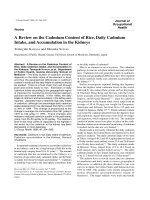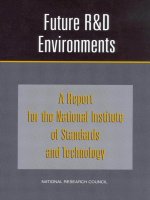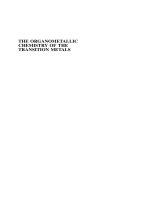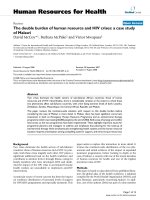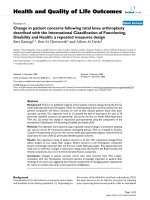Rolando m a roque malherbe the physical chemistry of materials energy and environmental applications (2009)
Bạn đang xem bản rút gọn của tài liệu. Xem và tải ngay bản đầy đủ của tài liệu tại đây (7.19 MB, 524 trang )
PHYSICAL
CHEMISTRY OF
MATERIALS
THE
ENERGY AND
ENVIRONMENTAL APPLICATIONS
www.pdfgrip.com
www.pdfgrip.com
PHYSICAL
CHEMISTRY OF
MATERIALS
THE
ENERGY AND
ENVIRONMENTAL APPLICATIONS
ROLANDO M.A. ROQUE-MALHERBE
Boca Raton London New York
CRC Press is an imprint of the
Taylor & Francis Group, an informa business
www.pdfgrip.com
CRC Press
Taylor & Francis Group
6000 Broken Sound Parkway NW, Suite 300
Boca Raton, FL 33487-2742
© 2010 by Taylor and Francis Group, LLC
CRC Press is an imprint of Taylor & Francis Group, an Informa business
No claim to original U.S. Government works
Printed in the United States of America on acid-free paper
10 9 8 7 6 5 4 3 2 1
International Standard Book Number: 978-1-4200-8272-2 (Hardback)
This book contains information obtained from authentic and highly regarded sources. Reasonable efforts have been
made to publish reliable data and information, but the author and publisher cannot assume responsibility for the validity of all materials or the consequences of their use. The authors and publishers have attempted to trace the copyright
holders of all material reproduced in this publication and apologize to copyright holders if permission to publish in this
form has not been obtained. If any copyright material has not been acknowledged please write and let us know so we may
rectify in any future reprint.
Except as permitted under U.S. Copyright Law, no part of this book may be reprinted, reproduced, transmitted, or utilized in any form by any electronic, mechanical, or other means, now known or hereafter invented, including photocopying, microfilming, and recording, or in any information storage or retrieval system, without written permission from the
publishers.
For permission to photocopy or use material electronically from this work, please access www.copyright.com (http://
www.copyright.com/) or contact the Copyright Clearance Center, Inc. (CCC), 222 Rosewood Drive, Danvers, MA 01923,
978-750-8400. CCC is a not-for-profit organization that provides licenses and registration for a variety of users. For
organizations that have been granted a photocopy license by the CCC, a separate system of payment has been arranged.
Trademark Notice: Product or corporate names may be trademarks or registered trademarks, and are used only for
identification and explanation without intent to infringe.
Library of Congress Cataloging-in-Publication Data
Roque-Malherbe, Rolando M. A.
The physical chemistry of materials : energy and environmental applications / Rolando M.A.
Roque-Malherbe.
p. cm.
Includes bibliographical references and index.
ISBN 978-1-4200-8272-2 (hardcover : alk. paper)
1. Materials science. 2. Chemistry, Physical and theoretical. I. Title.
TA403.R567 2010
620.1’1--dc22
2009034795
Visit the Taylor & Francis Web site at
and the CRC Press Web site at
www.pdfgrip.com
To the loving memory of my mother, Silvia Malherbe;
my father, Rolando Roque;
my grandmothers, Maria Fernandez and Isidra Peña;
my grandfathers, Herminio Roque and Diego Malherbe;
and my favorite pets, Zeolita and Trosia
www.pdfgrip.com
www.pdfgrip.com
Contents
Preface.............................................................................................................................................xix
Author .............................................................................................................................................xxi
Chapter 1
Materials Physics ..........................................................................................................1
1.1
1.2
1.3
1.4
1.5
1.6
1.7
Introduction .......................................................................................................1
Crystallography .................................................................................................1
1.2.1 Crystalline Structure ............................................................................1
1.2.2 Crystallographic Directions and Planes ...............................................5
1.2.3 Octahedral and Tetrahedral Sites in the FCC Lattice ..........................5
1.2.4 Reciprocal Lattice ................................................................................ 6
Bloch Theorem ..................................................................................................7
Lattice Vibrations ............................................................................................ 10
1.4.1 Phonons .............................................................................................. 10
1.4.2 Bose–Einstein Distribution ................................................................ 13
1.4.3 Heat Capacity of Solids ...................................................................... 14
Electrons in Crystalline Solid Materials ......................................................... 17
1.5.1 Electron Gas ....................................................................................... 17
1.5.2 Fermi–Dirac Distribution ................................................................... 19
1.5.3 Density of States for the Electron Gas ............................................... 21
1.5.4 Energy Band Model............................................................................24
1.5.5 Molecular Orbital Approach for the Formation
of Energy Bands .................................................................................26
X-Ray Diffraction ............................................................................................ 30
1.6.1 General Introduction .......................................................................... 30
1.6.2 X-Ray Scattering ................................................................................ 31
1.6.3 Diffraction Conditions ....................................................................... 33
1.6.4 Powder Diffraction Method ............................................................... 35
1.6.5 Other Factors Affecting the Scattering Intensity
of a Powdered Sample ........................................................................ 36
1.6.5.1 Multiplicity Factor .............................................................. 36
1.6.5.2 Lorentz Factor ..................................................................... 37
1.6.5.3 Absorption Factor ............................................................... 37
1.6.5.4 Temperature Factor ............................................................. 38
1.6.6 Intensity of a Diffraction Peak ........................................................... 38
Dielectric Phenomena in Materials ................................................................. 39
1.7.1 Introduction ........................................................................................ 39
1.7.1.1 Electronic Polarization ....................................................... 39
1.7.1.2 Ionic Polarization ................................................................ 39
1.7.1.3 Dipolar (or Orientation) Polarization ..................................40
1.7.1.4 Hopping of Charge Carriers’ Polarization..........................40
1.7.1.5 Interfacial Polarization .......................................................40
1.7.2 Susceptibility and Dielectric Constant ...............................................40
1.7.3 Complex Permittivity ......................................................................... 41
1.7.4 Dielectric Relaxation .......................................................................... 42
1.7.5 Debye Relaxation Model for the Dipolar Mechanism .......................44
vii
www.pdfgrip.com
viii
Contents
1.7.6
Model to Describe Dielectric Relaxation for a Charge
Hopping Process.................................................................................46
1.8 Nuclear Magnetic Resonance .......................................................................... 52
1.8.1 Introduction ........................................................................................ 52
1.8.2 Nuclear Zeeman Effect ...................................................................... 53
1.8.3 Magnetization and Time Evolution of the Magnetization.................. 54
1.8.4 Nuclear Magnetic Resonance Experiment ......................................... 56
1.8.5 Spin-Lattice Relaxation Time (T1), Spin–Spin Relaxation
Time (T2), and the Bloch Equations.................................................... 56
1.9 Mössbauer Effect ............................................................................................. 58
1.9.1 Introduction ........................................................................................ 58
1.9.2 Mössbauer Effect ................................................................................ 58
References ..................................................................................................................60
Chapter 2
Structure of Adsorbents, Ion Exchangers, Ion Conductors,
Catalysts, and Permeable Materials ........................................................................... 63
2.1
2.2
2.3
2.4
2.5
2.6
Introduction ..................................................................................................... 63
Transition Metal Catalysts ............................................................................... 63
2.2.1 Metallic Catalysts’ Performance ........................................................ 63
2.2.2 Band Structure of Transition Metals ..................................................64
2.2.3 Body-Centered Cubic Iron as a Catalyst ............................................64
2.2.4 Face-Centered Cubic Platinum as a Catalyst ..................................... 65
2.2.5 Hexagonal Close-Packed Cobalt as a Catalyst ...................................66
2.2.6 Balandin Volcano Plot ........................................................................66
Nonmetallic Catalysts ..................................................................................... 67
2.3.1 Simple Oxides .................................................................................... 67
2.3.2 Rock-Salt-Structure Catalysts ............................................................ 68
2.3.3 Rutile-Type Catalyst ........................................................................... 68
2.3.4 Corundum-Type Catalysts .................................................................. 69
2.3.5 Wurtzite-Type Catalysts ..................................................................... 71
2.3.6 Fluorite-Type Catalysts ...................................................................... 71
2.3.7 Spinel-Type Catalysts ......................................................................... 71
2.3.8 Zinc Blende–Type Structure............................................................... 72
Permeable Materials ........................................................................................ 73
2.4.1 Introduction ........................................................................................ 73
2.4.2 Palladium: A Hydrogen Permeable Material ..................................... 73
2.4.3 Yttrium Oxide (Y2O3)-Stabilized Zirconium
Oxide (ZrO2) ...................................................................................... 74
2.4.4 Hydrogen-Permeable Perovskites ....................................................... 74
2.4.5 Silver Iodide: A Fast Ion Conductor ................................................... 75
Crystalline and Ordered Nanoporous Adsorbents and Catalysts .................... 76
2.5.1 Zeolite Adsorbents ............................................................................. 76
2.5.2 Mesoporous Molecular Sieve Adsorbents .......................................... 78
2.5.3 Zeolite Catalysts ................................................................................. 79
2.5.4 Pillared Clay Catalysts ....................................................................... 79
Ion-Exchange Crystalline Materials ................................................................80
2.6.1 Zeolites ...............................................................................................80
2.6.2 Hydrotalcites ...................................................................................... 81
www.pdfgrip.com
Contents
ix
2.6.3
Titanates ............................................................................................. 82
2.6.3.1 Alkali Metal Titanates ........................................................ 82
2.6.3.2 Titanium Silicates ............................................................... 82
2.6.4 Zirconium Phosphates ........................................................................ 83
2.7 Amorphous Silica Adsorbents and Catalytic Supports ...................................84
2.7.1 Amorphous Silica ...............................................................................84
2.7.2 Amorphous Silica as Adsorbents and
Catalytic Supports .............................................................................. 86
2.8 Active Carbon and Other Carbon Forms as Adsorbents
and Catalytic Supports .................................................................................... 86
2.9 Polymers .......................................................................................................... 88
2.9.1 Introduction ........................................................................................ 88
2.9.2 Polymer Structure............................................................................... 89
2.9.2.1 Linear or Chain Polymers................................................... 89
2.9.2.2 Branched Polymers ............................................................. 93
2.9.2.3 Cross-Linked Polymers ...................................................... 93
2.9.3 Furfural Resins ................................................................................... 95
2.9.4 Coordination Polymers ....................................................................... 95
References ..................................................................................................................97
Chapter 3
Synthesis Methods of Catalyst Adsorbents, Ion Exchangers,
and Permeable Materials .......................................................................................... 103
3.1
3.2
3.3
3.4
Introduction ................................................................................................... 103
3.1.1 Nucleation and Growth: Johnson–Mehl–Avrami Equation ............. 103
Methods for the Preparation of Metallic-Supported Catalysts ..................... 105
3.2.1 Deposition of the Active Component ............................................... 105
3.2.1.1 Impregnation ..................................................................... 105
3.2.1.2 Grafting ............................................................................ 106
3.2.1.3 Precipitation ...................................................................... 106
3.2.1.4 Bifunctional Zeolite Catalysts .......................................... 107
3.2.1.5 Chemical Vapor Deposition .............................................. 107
3.2.1.6 Case Study: Preparation of Ni Bifunctional Catalysts
Supported on Homoionic: Na, K, Ca, and Mg
Clinoptilolite ..................................................................... 108
Synthesis of Inorganic Solids ........................................................................ 110
3.3.1 Solid-State Reaction Method ........................................................... 110
3.3.2 Solgel Methodologies ....................................................................... 111
3.3.2.1 Introduction ...................................................................... 111
3.3.2.2 Pechini Method ................................................................. 112
3.3.3 Solgel Route Based on the Hydrolysis–Condensation
of Metal Alkoxides ........................................................................... 112
3.3.4 Acetate Precipitation ........................................................................ 115
Synthesis of Microporous Crystalline Materials........................................... 116
3.4.1 Aluminosilicate Synthesis ................................................................ 116
3.4.2 High-Silica, All-Silica, and Non-Aluminosilicate Zeolites
Synthesis........................................................................................... 116
3.4.3 Hydrothermal Transformation of Clinoptilolite to Produce
Zeolites Na-X and Na-Y ................................................................... 117
www.pdfgrip.com
x
Contents
3.4.4
3.4.5
Synthesis of MeAPO Molecular Sieves ........................................... 121
Synthesis of Pillared, Layered Crystalline
Microporous Materials ..................................................................... 122
3.5 Synthesis of Ordered Silica Mesoporous Materials ...................................... 124
3.6 Active Carbon and Carbon Nanotube Preparation Methods ......................... 125
3.7 Membrane Preparation Methods ................................................................... 126
3.7.1 Ceramic Method ............................................................................... 126
3.7.2 Template Leaching ........................................................................... 127
3.7.3 Composite Membranes ..................................................................... 128
3.8 Polymer Synthesis ......................................................................................... 129
3.8.1 Step-Growth Polymerization............................................................ 129
3.8.2 Chain Reaction or Addition Polymerization .................................... 130
References ................................................................................................................ 130
Chapter 4
Material Characterization Methods ......................................................................... 137
4.1
4.2
4.3
4.4
4.5
Introduction ................................................................................................... 137
Application of XRD in Material Characterization ........................................ 137
4.2.1 Bragg–Brentano Geometry Powder Diffractometer ........................ 137
4.2.2 Intensity of a Diffraction Peak of a Powdered Sample .................... 138
4.2.3 Qualitative Identification of Phases.................................................. 138
4.2.4 Rietveld Method ............................................................................... 139
4.2.5 Quantitative Phase Analysis ............................................................. 141
4.2.6 Lattice Parameter Determination ..................................................... 144
4.2.6.1 Examples of the Use of Lattice Parameter
Determination in the Study of Materials .......................... 147
4.2.7 Scherrer–Williamson–Hall Methodology for Crystallite Size
Determination................................................................................... 147
Electron Microscopy ..................................................................................... 148
4.3.1 Introduction ...................................................................................... 148
4.3.2 Transmission Electron Microscope .................................................. 149
4.3.3 Scanning Electron Microscope ........................................................ 150
4.3.4 SEM Applications ............................................................................ 153
Energy-Dispersive Analysis of X-Rays ......................................................... 154
4.4.1 X-Ray Emission ................................................................................ 154
4.4.2 Applications of Energy-Dispersive Analysis of X-Rays .................. 156
Infrared and Raman Spectrometries ............................................................. 157
4.5.1 Introduction ...................................................................................... 157
4.5.2 Differences and Similarities between IR and Raman
Phenomena ....................................................................................... 158
4.5.3 Molecular Vibrations ........................................................................ 158
4.5.4 Dipole Moment and Polarization ..................................................... 159
4.5.5 Types of Transitions between States ................................................ 160
4.5.6 IR and Raman Transition Probabilities ............................................ 162
4.5.7 Selection Rules ................................................................................. 163
4.5.8 Simplification of the Molecular Vibration Analysis ........................ 165
4.5.9 Instrumentation ................................................................................ 166
4.5.9.1 Fourier Transform Infrared Spectrometer ........................ 166
4.5.9.2 Conventional Raman Spectrometer .................................. 167
4.5.9.3 Fourier Transform Raman Spectrometer .......................... 167
www.pdfgrip.com
Contents
xi
4.5.10 Applications of Fourier Transform Infrared Spectroscopy
and Raman Spectroscopy in Materials Science ............................... 168
4.6 Nuclear Magnetic Resonance Spectrometry ................................................. 173
4.6.1 Introduction ...................................................................................... 173
4.6.2 NMR Spectra.................................................................................... 173
4.6.3 Chemical Shift.................................................................................. 175
4.6.4 Spin–Spin Coupling ......................................................................... 176
4.6.5 Magic Angle Spinning-Nuclear Magnetic Resonance ..................... 176
4.6.6 Applications of MAS-NMR ............................................................. 177
4.7 Thermal Methods of Analysis ....................................................................... 179
4.7.1 Differential Thermal Analysis ......................................................... 180
4.7.2 Thermal Gravimetric Analysis......................................................... 181
4.7.3 Differential Scanning Calorimetry .................................................. 182
4.7.4 Temperature-Programmed Reduction .............................................. 182
4.7.5 Temperature-Programmed Desorption ............................................ 183
4.7.6 Fourier Transform Infrared-Temperature
Programmed Desorption .................................................................. 184
4.8 Dielectric Analysis Methods ......................................................................... 187
4.8.1 Introduction ...................................................................................... 187
4.8.2 Thermodielectric Analyzer .............................................................. 189
4.8.3 Thermodielectric Analysis ............................................................... 191
4.8.3.1 First Effect in TDA ........................................................... 191
4.8.3.2 Second Effect in TDA....................................................... 194
4.8.3.3 Third Effect in TDA ......................................................... 194
4.8.4 Dielectric Spectroscopy.................................................................... 196
4.9 Mössbauer Spectrometry ............................................................................... 201
4.9.1 Introduction ...................................................................................... 201
4.9.2 Mössbauer Spectrometer .................................................................. 201
4.9.3 Hyperfine Interactions ...................................................................... 203
4.9.3.1 Chemical or Isomer Shift..................................................203
4.9.3.2 Quadrupole Splitting ........................................................204
4.9.3.3 Magnetic Splitting ............................................................207
4.9.4 Applications of 57Fe Mössbauer Spectrometry.................................208
4.10 Mercury Porosimetry..................................................................................... 211
4.11 Magnetic Force in Nonuniform Fields: Phase Analysis Method .................. 213
References ................................................................................................................ 214
Chapter 5
Diffusion in Materials .............................................................................................. 219
5.1
5.2
5.3
5.4
5.5
Introduction ................................................................................................... 219
Fick’s Laws .................................................................................................... 219
Thermodynamics of Irreversible Processes .................................................. 220
Diffusion Coefficients ................................................................................... 222
5.4.1 Tracer-Diffusion Coefficient and Self-Diffusion
Coefficient ........................................................................................ 222
5.4.2 Intrinsic Diffusion Coefficient: The Kirkendall Effect .................... 223
5.4.3 Interdiffusion or Chemical Diffusion Coefficient ............................ 226
Microscopic Description of Diffusion ........................................................... 226
5.5.1 Introduction ...................................................................................... 226
5.5.2 Random Walker in One Dimension ................................................. 227
www.pdfgrip.com
xii
Contents
5.5.3
5.5.4
Fokker–Planck Equation .................................................................. 228
Diffusion Mechanisms in Crystalline Solids ................................... 229
5.5.4.1 Vacancy Mechanism ......................................................... 230
5.5.4.2 Interstitial Mechanism ...................................................... 231
5.5.5 Random Walker in a Cubic Crystalline Structure ........................... 232
5.6 Some Diffusion Processes in Metals ............................................................. 234
5.6.1 Hydrogen Diffusion in Metals.......................................................... 234
5.6.2 Formation of a Surface Fe–Ni Alloy................................................ 235
5.6.3 Effect of the Diffusion of Fe in a Fe–Ni Alloy during the
Oxidation of the Alloy with Nitric Oxide ........................................ 239
5.7 Diffusion in Oxides .......................................................................................240
5.7.1 Defect Chemistry of Oxides .............................................................240
5.7.2 Oxygen Transport in Oxides ............................................................ 243
5.7.3 Defect Chemistry in Proton-Conducting Perovskites ...................... 245
5.7.4 Proton Transport Mechanisms .........................................................246
5.7.5 Band Structure of Proton-Conducting Perovskites .......................... 247
5.7.6 Proton Transport Mechanism in Oxides .......................................... 247
5.7.7 Absorption and Diffusion of Hydrogen in Nanocrystals of the
BaCe0.95Yb0.05O3−d Proton-Conducting Perovskite ........................... 249
5.8 Diffusion in Porous Media ............................................................................ 254
5.8.1 Transport Mechanisms in Porous Media ......................................... 254
5.8.2 Viscous versus Knudsen Flows ........................................................ 256
5.8.3 Viscous Flow in a Straight Cylindrical Pore .................................... 257
5.8.4 Knudsen Flow in a Straight Cylindrical Pore .................................. 257
5.9 Diffusion in Micropores ................................................................................ 258
5.9.1 Mechanism of Diffusion in Zeolites ................................................ 258
5.9.2 Single-Component Diffusion in Zeolites ......................................... 263
5.9.3 Two-Component Diffusion in Zeolites ............................................ 269
References ................................................................................................................ 271
Chapter 6
Adsorption in Nanoporous Materials ....................................................................... 275
6.1
6.2
6.3
6.4
6.5
Introduction ................................................................................................... 275
Definitions and Terminology ......................................................................... 275
6.2.1 Some Definitions .............................................................................. 275
6.2.1.1 Adsorption and Desorption............................................... 275
6.2.1.2 Pore Size ........................................................................... 276
6.2.1.3 Adsorption Space Filling .................................................. 276
6.2.1.4 Dynamic Adsorption ........................................................ 276
6.2.1.5 Adsorption Isotherm ......................................................... 276
6.2.1.6 Physical and Chemical Adsorptions ................................. 276
6.2.1.7 Mobile and Immobile Adsorptions ................................... 276
6.2.1.8 Monolayers and Multilayers ............................................. 276
6.2.1.9 Parameters Characterizing Porous
Adsorbents ........................................................................ 276
6.2.2 Magnitude of Adsorption ................................................................. 277
Adsorption Interaction Fields ........................................................................ 278
Measurement of Adsorption Isotherms by the
Volumetric Method ........................................................................................ 282
Thermodynamics of Adsorption ................................................................... 283
6.5.1 Isosteric and Differential Heats of Adsorption ................................ 283
6.5.2 Calorimetry of Adsorption ............................................................... 285
www.pdfgrip.com
Contents
xiii
6.5.3
Some Relations between Macroscopic and Microscopic
Adsorption Parameters ..................................................................... 288
6.6 Systems for the Automatic Measurement of Surface Area
and Porosity by the Volumetric Method ........................................................290
6.6.1 Equipment ........................................................................................ 290
6.6.2 Porous Material Characterization by Adsorption Methods ............. 290
6.7 Adsorption in Zeolites ................................................................................... 291
6.7.1 Introduction ...................................................................................... 291
6.7.2 Some Examples of Adsorption Systems in Zeolites ........................ 292
6.7.3 Determination of the Micropore Volume ......................................... 292
6.7.3.1 Dubinin Adsorption Isotherm Equation ........................... 292
6.7.3.2 Osmotic Adsorption Isotherm Equation ........................... 294
6.7.3.3 Langmuir-Type and Fowler–Guggenheim-Type
Adsorption Isotherm Equations ........................................ 295
6.8 Adsorption in Nanoporous-Ordered and Amorphous Materials................... 297
6.8.1 Mesoporous Molecular Sieves.......................................................... 297
6.8.2 Amorphous Silica ............................................................................. 298
6.8.3 Adsorption in Active Carbon and Carbon Nanotubes .....................300
6.8.4 Determination of the Specific Surface of Materials ........................ 301
6.9 Howarth–Kawazoe Approach for the Description of Adsorption in
Microporous Materials for the Slit, Cylindrical, and Spherical Pore
Geometries..................................................................................................... 303
6.10 Adsorption from Liquid Solutions ................................................................. 310
6.10.1 Introduction ...................................................................................... 310
6.10.2 Isotherms for the Description of Adsorption from Liquid Phase..... 310
6.11 Dynamic Adsorption: The Plug-Flow Adsorption Reactor ........................... 312
6.11.1 Dynamic Adsorption ........................................................................ 312
6.11.2 Plug-Flow Adsorption Reactor Model.............................................. 314
6.12 Some Chemical, Sustainable Energy, and Pollution Abatement
Applications of Nanoporous Adsorbents ....................................................... 317
6.12.1 Gas Separation and Cleaning ........................................................... 317
6.12.2 Hydrogen Storage ............................................................................. 321
6.12.2.1 Hydrogen Storage in Zeolites ........................................... 321
6.12.2.2 Hydrogen Storage in Mesoporous Molecular
Sieves and Pillared Clays.................................................. 322
6.12.2.3 Hydrogen Storage in Silica ............................................... 322
6.12.2.4 Hydrogen Storage in Carbon-Based Adsorbents .............. 324
6.12.3 Methane Storage in Adsorbents ....................................................... 325
6.12.3.1 Introduction ...................................................................... 325
6.12.3.2 Methane Storage in Carbonaceous Adsorbents ................ 326
6.12.4 Water Cleaning ................................................................................. 327
6.13 Porous Polymers as Adsorbents..................................................................... 329
6.13.1 Porous and Coordination Polymers .................................................. 329
6.13.2 Applications of Porous Polymers and Coordination Polymers in
Adsorption Processes ....................................................................... 331
References ................................................................................................................ 333
Chapter 7
Ion Exchange ............................................................................................................ 339
7.1
7.2
7.3
Introduction ................................................................................................... 339
Aluminosilicate Zeolite Ion Exchangers ....................................................... 339
Some Definitions and Terms .........................................................................340
www.pdfgrip.com
xiv
Contents
7.4
7.5
Thermodynamics of Ion Exchange................................................................ 342
Rules Governing the Ion-Exchange Equilibrium in Zeolites ........................344
7.5.1 Regular Systems ...............................................................................344
7.5.2 Space Limitations and Molecular Sieving .......................................344
7.5.3 Irregular Systems ............................................................................. 345
7.5.4 Systems with Phase Transformations ............................................... 345
7.5.5 Electroselectivity .............................................................................. 345
7.5.6 Effect of pH of the Electrolytic Solution on the
Ion-Exchange Process ...................................................................... 345
7.6 Ion-Exchange Heat ........................................................................................346
7.6.1 Ion-Exchange Heat Measurement ....................................................346
7.7 Ion-Exchange Selectivity in Zeolites ............................................................. 349
7.8 Ion-Exchange Kinetics .................................................................................. 350
7.8.1 Interdiffusion in the Adhering Liquid Thin Layer as the
Limiting Step .................................................................................... 350
7.8.2 Interdiffusion of A and B in Zeolite Crystals
as the Limiting Step ......................................................................... 352
7.8.3 Experimental Results ....................................................................... 353
7.9 Plug-Flow Ion-Exchange Bed Reactors ......................................................... 353
7.9.1 Introduction ...................................................................................... 353
7.9.2 Parameters for the Design of a Laboratory PFIER .......................... 355
7.10 Chemical and Pollution Abatement Applications of Ion Exchange
in Zeolites ...................................................................................................... 355
7.10.1 Introduction ...................................................................................... 355
7.10.2 Heavy Metal Removal from Wastewater ......................................... 356
7.10.3 Recovery of Ni2+ from the Waste Liquors
of a Nickel Production Plant............................................................. 361
7.10.4 Municipal Wastewater Treatment..................................................... 361
7.10.5 Radioactive Wastewater Treatment .................................................. 362
7.10.6 Catalytic Effect of Proton Exchange in Natural Zeolites
in Biogas Production During Anaerobic Digestion.......................... 363
7.10.7 Zeolite Na-A as Detergent Builder ...................................................364
7.10.8 Aquaculture ......................................................................................364
7.11 Applications of Other Crystalline Inorganic Ion Exchangers ....................... 365
7.11.1 Hydrotalcites .................................................................................... 365
7.11.2 Sodium Titanates .............................................................................. 366
7.11.3 Titanium Silicates............................................................................. 366
7.11.4 Zirconium Phosphates ...................................................................... 367
7.12 Ion-Exchange Polymeric Resins .................................................................... 367
7.12.1 General Characteristics of Ion-Exchange Resins ............................. 367
7.12.2 Ion-Exchange Resin Swelling .......................................................... 368
7.12.3 Applications of Ion-Exchange Polymeric Resins ............................. 370
References ................................................................................................................ 371
Chapter 8
Solid-State Electrochemistry ................................................................................... 375
8.1
Introduction ................................................................................................... 375
8.1.1 Batteries and Fuel Cells.................................................................... 375
8.1.2 Types of Fuel Cells ........................................................................... 375
8.1.2.1 Polymer Electrolyte Fuel Cell........................................... 376
8.1.2.2 Alkaline Fuel Cell ............................................................ 377
8.1.2.3 Phosphoric Acid Fuel Cell ................................................ 378
www.pdfgrip.com
Contents
xv
8.1.2.4 Molten Carbonate Fuel Cell.............................................. 379
8.1.2.5 Solid Oxide Fuel Cell ....................................................... 380
8.2 Solid Electrolytes........................................................................................... 380
8.2.1 Defect Concentration in Ionic Compounds ...................................... 381
8.2.2 Unipolar Ionic Conductivity in Solids.............................................. 381
8.2.3 Examples of Unipolar Cationic Conductors ..................................... 384
8.2.4 Anionic Conductors.......................................................................... 385
8.2.5 Proton Conductors ............................................................................ 385
8.2.5.1 Introduction ...................................................................... 385
8.2.5.2 Conductivity in Proton Conductors .................................. 385
8.2.6 Oxide Conduction............................................................................. 386
8.2.6.1 Oxygen Conductors .......................................................... 386
8.2.6.2 Conductivity in Oxygen Conductors................................. 388
8.2.7 Zeolite Electrolyte ............................................................................ 389
8.3 Thermodynamics of Electrochemical Processes........................................... 392
8.4 Kinetics of Electrochemical Processes ......................................................... 393
8.4.1 Overpotential .................................................................................... 393
8.4.2 Activation Polarization ..................................................................... 394
8.4.2.1 Tafel Equation ................................................................... 394
8.4.2.2 Calculation of the Transference Coefficient ..................... 395
8.4.3 Ohmic Polarization .......................................................................... 398
8.4.4 Concentration Polarization ............................................................... 398
8.5 Fuel Cell Efficiency ....................................................................................... 398
8.5.1 Polarization Curve............................................................................ 398
8.5.2 Thermodynamic Efficiency of a Fuel Cell ....................................... 399
8.5.3 Electrochemical Efficiency of a Fuel Cell........................................400
8.5.4 Efficiency of an Internal Combustion Engine .................................. 401
8.6 Electrochemical Impedance Spectroscopy ................................................... 401
8.6.1 Impedance Analysis ......................................................................... 401
8.6.2 Dielectric Spectroscopy and Impedance Spectroscopy ...................402
8.6.3 Equivalent Circuits for Electrochemical Cells .................................404
8.6.4 Methods for the Representation of Impedance
Spectroscopy Data ............................................................................405
8.7 Sustainable Energy and Environmental Sensing Technology
Applications of Solid-State Electrochemistry ...............................................407
8.7.1 Solid Oxide Fuel Cell Materials and Performance ..........................407
8.7.1.1 Electrolyte .........................................................................407
8.7.1.2 SOFC Cathode Materials and Performance .....................408
8.7.1.3 SOFC Anode Materials and Performance ........................409
8.7.1.4 Interconnects..................................................................... 410
8.7.1.5 SOFC Fuel Processing ...................................................... 410
8.7.2 Polymer Electrolyte Fuel Cells......................................................... 412
8.7.2.1 Electrolyte ......................................................................... 412
8.7.2.2 Electrodes ......................................................................... 413
8.7.3 Zeolites as Solid Electrolytes in Batteries........................................ 413
8.7.4 Sensors ............................................................................................. 414
References ................................................................................................................ 416
Chapter 9
Heterogeneous Catalysis and Surface Reactions ..................................................... 421
9.1
9.2
Introduction ................................................................................................... 421
General Properties of Catalysts ..................................................................... 421
www.pdfgrip.com
xvi
Contents
9.3
9.4
9.5
9.6
9.7
9.8
9.9
Crystalline and Ordered Nanoporous Heterogeneous Catalysts ................... 423
9.3.1 Acid Zeolite Catalysts: Brönsted Type ............................................. 423
9.3.2 Bifunctional Zeolite Catalysts .......................................................... 425
9.3.3 Acid Zeolite Catalysts: Lewis Type ................................................. 425
9.3.4 Basic Zeolite Catalysts ..................................................................... 425
9.3.5 Catalysts Obtained by the Isomorphous Substitution
of Ti in Zeolites ................................................................................ 426
9.3.6 Pillared Clays ................................................................................... 426
9.3.7 Mesoporous Molecular Sieves.......................................................... 428
Amorphous, Porous Heterogeneous Catalysts and Supports ........................ 428
9.4.1 Amorphous Acid Silica–Alumina .................................................... 428
9.4.2 Metallic Catalysts Supported on Amorphous Materials .................. 429
Photocatalysts ................................................................................................ 430
9.5.1 Introduction ...................................................................................... 430
9.5.2 Titanium Oxide ................................................................................ 430
9.5.3 Other Photocatalysts......................................................................... 431
Kinetics of Surface Reactions ....................................................................... 431
9.6.1 Steps in a Heterogeneous Catalytic Reaction................................... 431
9.6.2 Reaction Rate ................................................................................... 432
9.6.3 Unimolecular Decomposition .......................................................... 433
9.6.4 Calculation of the Adsorption Enthalpy of n-Paraffins in
Nanoporous Crystalline and Ordered Acid Catalysts, and Its
Relation with the Activation Energy of the Monomolecular
Catalytic Cracking Reaction ............................................................ 435
9.6.4.1 Introduction ...................................................................... 435
9.6.4.2 Unimolecular Catalytic Cracking ..................................... 436
9.6.4.3 Calculation of the Adsorption Enthalpy ........................... 436
9.6.4.4 Calculation of the Activation Energy ............................... 438
9.6.4.5 Numerical Evaluation of the Model..................................440
9.6.5 Bimolecular Reaction ....................................................................... 441
9.6.5.1 Langmuir–Hinshelwood Mechanism ............................... 441
9.6.5.2 Eley–Rideal Mechanism ................................................... 442
9.6.6 Composite Mechanism Reactions .................................................... 443
Examples of Surface Reactions .....................................................................444
9.7.1 Reaction between Nitric Oxide and the Surface of Iron ..................444
9.7.2 Reaction between Carbon Monoxide and the Surface
of Nickel ........................................................................................... 447
Packed Bed Plug-Flow Catalytic Reactor......................................................449
9.8.1 Laboratory Scale Reactor .................................................................449
9.8.2 Equations Governing the Plug-Flow Packed Bed Reactor ............... 450
9.8.3 Solution of the Governing Equation for the First-Order
Chemical Reaction ........................................................................... 451
9.8.4 Steps in a Catalytic Reaction in a Packed-Bed Reactor ................... 452
Chemical, Sustainable Energy, and Pollution Abatement Applications
of Heterogeneous Catalysts ........................................................................... 453
9.9.1 Ammonia Synthesis ......................................................................... 453
9.9.2 Catalytic Cracking of Hydrocarbons................................................ 454
9.9.3 Decomposition of Ammonia for Hydrogen Production
and Other Applications .................................................................... 454
9.9.4 Fischer–Tropsch Synthesis ............................................................... 455
www.pdfgrip.com
Contents
xvii
9.9.5
Water–Gas Shift Reaction for Hydrogen Production
and Other Applications .................................................................... 455
9.9.6 Ethanol Dehydration ........................................................................ 456
9.9.7 Oxidation of CO ............................................................................... 458
9.9.8 Water Treatment by Heterogeneous Photocatalysis ......................... 459
9.9.9 Other Sources of Activation of a Photocatalyst
Mechanical Activation ..................................................................... 459
9.9.10 Hydrogen Production by Photocatalytic Water Splitting .................460
9.9.10.1 Solar Water Splitting with Quantum Boost .....................460
9.9.11 Hydrogen Production by Steam-Reforming of Ethanol ................... 461
9.9.12 Porous Polymers as Catalysts ........................................................... 462
References ................................................................................................................ 462
Chapter 10 Membranes .............................................................................................................. 467
10.1
10.2
Introduction .................................................................................................. 467
Definitions and Nomenclature...................................................................... 467
10.2.1 Some Definitions ............................................................................ 467
10.2.2 Membrane Unit ...............................................................................468
10.2.3 Permeance and Permeability ..........................................................468
10.2.4 Selectivity .......................................................................................469
10.3 Permeability in Dense Membranes .............................................................. 470
10.3.1 Hydrogen Transport in Metallic Dense Membranes ...................... 470
10.3.2 Hydrogen Permeation in Oxide Ceramic Membranes.................... 471
10.3.3 Permeation in Dense Oxide Membranes ........................................ 473
10.4 Permeation in Porous Membranes................................................................ 474
10.4.1 Introduction .................................................................................... 474
10.4.2 Transport Mechanisms in Porous Membranes ............................... 474
10.4.3 Viscous and Knudsen Flows ........................................................... 475
10.4.4 Darcy’s Law for Viscous Flow ....................................................... 475
10.4.5 Darcy’s Law for Knudsen Flow ...................................................... 477
10.4.6 Transport in Zeolite Membranes .................................................... 477
10.4.7 Zeolite-Based Membranes .............................................................. 478
10.4.8 Permeation Flow in Zeolite Membranes ........................................ 478
10.5 Zeolite-Based Ceramic Porous Membrane ..................................................480
10.5.1 Carbon Dioxide Permeation in a Zeolite-Based
Ceramic Porous Membrane ............................................................480
10.5.2 In Situ Synthesis of an AlPO4 –5 Zeolite over a Ceramic
Porous Membrane ........................................................................... 482
10.6 Chemical, Sustainable Energy, and Pollution Abatement Applications
of Inorganic Membranes .............................................................................. 483
10.6.1 Hydrogen and Oxygen Separations ................................................ 483
10.6.1.1 Hydrogen Separations ..................................................... 483
10.6.1.2 Oxygen Separations ........................................................484
10.6.2 Catalytic Membrane Reactors ........................................................484
10.7 Examples of Polymeric Membranes............................................................. 485
References ............................................................................................................... 487
Index .............................................................................................................................................. 491
www.pdfgrip.com
www.pdfgrip.com
Preface
Since ancient times, the development and use of materials has been one of the basic objectives of
mankind. Eras, that is, the Stone Age, the Bronze Age, and the Iron Age, have been named after
the fundamental material used by mankind to construct their tools. Materials science is the modern
activity that provides the raw material for this endless need, demanded by the progress in all fields
of industry and technology, of new materials for the development of society.
Metallurgy was one of the first fields where material scientists worked toward developing new
alloys for different applications. During the first years, a large number of studies were carried out
on the austenite–martensite–cementite phases achieved during the phase transformations of the iron–
carbon alloy, which is the foundation for steel production, later the development of stainless steel,
and other important alloys for industry, construction, and other fields was produced.
Later, the evolution of the electronic industry initiated the development of an immense variety of
materials and devises based, essentially, on the properties of semiconductor, dielectric, ferromagnetic,
superconductor, and ferroelectric materials.
In addition, until the second half of the twentieth century, the term ceramic was related to
the traditional clays, that is, pottery, bricks, tiles, and cements and glass; however, during the last
50 years, the field of technical ceramics has been rapidly developed, and firmly established.
At the beginning of the twentieth century, the first synthetic polymer, bakelite, was obtained and
later, after the First World War, it was proposed that polymers consisted of long chains of atoms
held together by covalent bonds. The Second World War gave a huge stimulus to the creation of
polymers, which firmly established the field of polymers.
However, important groups of materials cannot be studied in a single volume materials science
book. These materials include adsorbents, ion exchangers, ion conductors, catalysts, and permeable
materials. Examples of these types of materials are perovskites, zeolites, mesoporous molecular
sieves, silica, alumina, active carbons, titanium dioxide, magnesium oxide, clays, pillared clays,
hydrotalcites, alkali metal titanates, titanium silicates, polymers, and coordination polymers. These
materials have applications in many fields, among others, adsorption, ion conduction, ion exchange,
gas separation, membrane reactors, catalysts, catalytic supports, sensors, pollution abatement,
detergents, animal nutrition, agriculture, and sustainable energy applications.
The author of this book has been permanently active during his career in the field of materials science,
studying diffusion, adsorption, ion exchange, cationic conduction, catalysis and permeation in metals,
zeolites, silica, and perovskites. From his experience, the author considers that during the last years, a
new field in materials science, that he calls the “physical chemistry of materials,” which emphasizes
the study of materials for chemical, sustainable energy, and pollution abatement applications, has
been developed. With regard to this development, the aim of this book is to teach the methods of
syntheses and characterization of adsorbents, ion exchangers, cationic conductors, catalysts, and
permeable porous and dense materials and their properties and applications.
Rolando M.A. Roque-Malherbe
Las Piedros, PR, USA
January, 2009
xix
www.pdfgrip.com
www.pdfgrip.com
Author
Dr. Rolando M. A. Roque-Malherbe was born in 1948 in Güines,
Havana, Cuba. He graduated with a BS in physics from the
University of Havana (1970), summa cum laude, specialized (MS
equivalent degree) in surface physics at the National Center for
Scientific Research, Technical University of Dresden, Germany
(1972), magna cum laude, and obtained his PhD in physics (solid
state physics) from the Moscow Institute of Steel and Alloys,
Russia (1978), magna cum laude. He completed postdoctoral stints
at the Technical University of Dresden, Germany; Moscow State
University, Russia; the Technical University of Budapest, Hungary;
the Institute of Physical Chemistry and Chemical Physics, Russian Academy of Science, Moscow;
and the Central Research Institute for Chemistry, Hungarian Academy of Science, Budapest
(1978–1984). The group led by him at the National Center for Scientific Research, Higher
Pedagogical Institute, Varona, Havana, Cuba (1980–1992), was one of the world leaders in the study
and applications of natural zeolites. During this period, he was possibly the only Cuban scientist to
receive most awards. In 1993, after a political confrontation with the Cuban regime, he left Cuba
with his family as a political refugee. From 1993 to 1999, he worked at various institutions like the
Institute of Chemical Technology, Valencia, Spain; at Clark Atlanta University, Atlanta, Georgia;
and at Barry University, Miami, Florida. From 1999 to 2004, he was dean and full professor at
the School of Sciences in the University of Turabo, Gurabo, Puerto Rico, and currently he is the
director of the Institute of Physical and Chemical Applied Research. He has published 121 papers,
5 books, 6 chapters, 30 abstracts, has 15 patents, and made more than 200 presentations at scientific
conferences. He is currently an American citizen.
xxi
www.pdfgrip.com
www.pdfgrip.com
1 Materials Physics
1.1 INTRODUCTION
We discuss briefly some basic topics in materials physics such as crystallography, lattice vibrations,
band structure, x-ray diffraction, dielectric relaxation, nuclear magnetic resonance and Mössbauer
effects in this chapter. These topics are an important part of the core of this book. Therefore, an
initial analysis of these topics is useful, especially for those readers who do not have a solid background
in materials physics, to understand some of the different problems that are examined later in the
rest of the book.
1.2 CRYSTALLOGRAPHY
1.2.1
CRYSTALLINE STRUCTURE
An unit cell is a regular repeating pattern that pervades the whole crystal lattice. It is described
−
[1–6] by three vectors: a−, b , and c− (Figure 1.1), that outline a parallelepiped, characterized by six
parameters. These parameters are the length of the three vectors (a, b, and c) and the angles between
them (α, β, and γ). Consequently, all the points that constitute the lattice sites are given by a set of
points, which starting from a reference point, are given by
R = n1 a + n2 b + n3 c
(1.1)
where n1, n2, n3, are integers running from −∞ to ∞, for a limitless crystal. As a result of this, the
lattice is a set of points in space, distinguished by a space periodicity or a translational symmetry.
This means that under a translation defined by Equation 1.1, the lattice remains invariant.
If all the lattice points are positioned in the eight corners of a unit cell, then the unit cell is called
a primitive unit cell. However, often, for convenience, larger unit cells, which are not primitives, are
selected for the description of a particular lattice, as will be explained later.
It is possible, as well, to define the primitive unit cell, by surrounding the lattice points, by planes
perpendicularly intersecting the translation vectors between the enclosed lattice point and its nearest
neighbors [2,3]. In this case, the lattice point will be included in a primitive unit cell type, which is
named the Wigner–Seitz cell (see Figure 1.2).
A concrete building procedure in three dimensions of the Wigner–Seitz cell can be achieved by
representing lines from a lattice point to others in the lattice and then drawing planes that cut in half
each of the represented lines, and finally taking the minimum polyhedron enclosing the lattice point
surrounded by the constructed planes.
Till now, we have only considered a mathematical set of points. However, a material, in
reality, is not merely an array of points, but the group of points is a lattice. A real crystalline
material is constituted of atoms periodically arranged in the structure, where the condition of
periodicity implies a translational invariance with respect to a translation operation, and where
−
a lattice translation operation, T , is defined as a vector connecting two lattice points, given by
Equation 1.1 as
T = n1 a + n2 b + n3 c
(1.2)
1
www.pdfgrip.com
2
The Physical Chemistry of Materials: Energy and Environmental Applications
z
–
c
α b–
β
c
y
γ
–
a
a
b
x
FIGURE 1.1
Unit cell geometrical representation.
Until now, we have considered an infinite lattice, but a real
material has limited dimensions, that is, n1, n2, n3 has boundaries.
However, an infinite array of unit cells is a good approximation
for regions relatively far from the surface, which constitutes the
major part of the whole material [5]. At this point, it is necessary
to recognize that a real crystal has imperfections, such as vacancies,
dislocations, and grain boundaries.
Since a lattice is just a set of points, we will need another
entity to describe the real crystal. That is, it is required to locate
a set of atoms named “basis” in the vicinity of the lattice sites.
Therefore, a crystal will be a combination of a lattice and a basis
of atoms. In Figure 1.3, a representation of the operation
Wigner–Seitz cell
FIGURE 1.2 Wigner–Seitz cell
in two dimensions.
lattice + basis = crystal
is given.
In order to systematize in a logical form the lattices that are compatible with a periodicity
condition, the French physicist Auguste Bravais, in 1845, demonstrated that the lattice points
in three dimensions, congruent with the periodicity requirement, are the roots of the following
trigonometric equation [2]:
b ρ
a
Lattice
FIGURE 1.3
+
Basis
Representation of the operation: lattice + basis = crystal.
www.pdfgrip.com
Crystal

